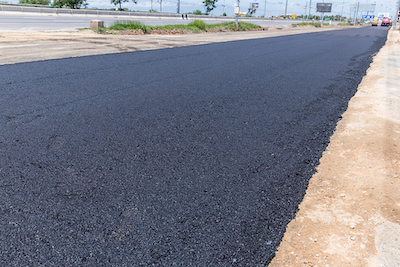Road infrastructure is essential to modern society, facilitating transportation, commerce, and communication. The two most common materials used for road construction are concrete and asphalt. This article aims to provide a comprehensive comparison of the two materials, evaluating their advantages and disadvantages in terms of cost, durability, maintenance, safety, and environmental impact.
I. Cost
- Initial cost
Asphalt is generally cheaper to install than concrete. The initial cost of asphalt roads ranges from $2 to $5 per square foot, while concrete roads can cost between $4 to $10 per square foot. This price difference is primarily due to the fact that asphalt is produced from oil, which is less expensive than the cement used in concrete. Additionally, the construction process for asphalt is less labor-intensive than concrete, further reducing the initial cost.
- Long-term cost
Though concrete roads have a higher initial cost, their long-term maintenance expenses tend to be lower. Concrete is more durable than asphalt, so it requires less frequent repairs and resurfacing. Over a 40-year period, the total cost of owning and maintaining a concrete road can be up to 28% less than an asphalt road.
II. Durability
- Lifespan
Concrete roads typically have a lifespan of 30 to 40 years, while asphalt roads have an expected service life of 12 to 20 years. The greater durability of concrete can be attributed to its higher strength and resistance to deformation, rutting, and cracking.
- Weather resistance
In terms of weather resistance, concrete holds a clear advantage. Concrete roads are less susceptible to damage from freeze-thaw cycles, which can cause asphalt roads to crack and develop potholes. In hot climates, concrete roads maintain their structural integrity better than asphalt roads, which can soften and become rutted under the stress of heavy traffic and high temperatures.
- Load-bearing capacity
Concrete roads have a higher load-bearing capacity than asphalt roads. They are better equipped to handle heavy traffic loads and are often used in industrial areas and on highways where heavy trucks are common. In contrast, asphalt roads are more suitable for light to moderate traffic and are often used in residential areas.
III. Maintenance
- Repair and resurfacing
Asphalt roads require more frequent repairs and resurfacing due to their shorter lifespan and increased susceptibility to damage from weather and traffic. Potholes can be patched relatively quickly and inexpensively, but the repairs are often temporary and may need to be repeated. Resurfacing an asphalt road typically involves removing the top layer and applying a new layer of asphalt. This process is less expensive than concrete repairs but needs to be done more frequently.
Concrete roads, on the other hand, require less frequent repairs. When cracks or damage do occur, the repair process can be more involved and expensive. However, due to the longer lifespan and reduced maintenance requirements, the overall long-term cost of concrete roads is generally lower.
- Maintenance during winter
Winter maintenance is another consideration when comparing concrete and asphalt roads. Snow and ice can be more easily removed from asphalt surfaces, as they retain more heat and can melt snow faster. Concrete roads, however, can be more challenging to maintain during winter, as they may require more frequent salting and plowing.
IV. Safety
- Skid resistance
Both asphalt and concrete roads can be designed to provide good skid resistance. However, over time, asphalt tends to lose its skid resistance faster than concrete due to wear and weathering. Periodic maintenance, such as applying a high-friction surface treatment, can help restore skid resistance to asphalt roads.
- Visibility
Concrete roads have a lighter color than asphalt roads, which can improve visibility for drivers, particularly at night or in wet conditions. This increased visibility can enhance safety by reducing the risk of accidents. Additionally, the lighter color of concrete can help reduce the urban heat island effect, as it reflects more sunlight and absorbs less heat compared to asphalt surfaces.
V. Environmental Impact
- Raw materials
Asphalt is derived from petroleum, which is a non-renewable resource. The production and use of asphalt contribute to the depletion of oil reserves and the generation of greenhouse gas emissions. Concrete, on the other hand, is primarily composed of cement, sand, and gravel, which are more abundant and less environmentally damaging resources.
- Recycling
Both asphalt and concrete roads can be recycled, although asphalt has a higher recycling rate. In fact, asphalt is considered one of the most recycled materials in the United States, with approximately 80% being reused in new road construction projects. Recycling asphalt reduces the demand for new petroleum products and helps conserve natural resources. Concrete can also be crushed and reused as aggregate in new concrete mixes or as a base material for roads, but the recycling rate for concrete is lower than that of asphalt.
- Carbon footprint
Concrete has a larger carbon footprint than asphalt, primarily due to the energy-intensive production of cement. The cement manufacturing process accounts for approximately 5% of global carbon dioxide emissions. However, innovations in concrete technology, such as the development of low-carbon cements and the use of supplementary cementitious materials like fly ash and slag, are helping to reduce the environmental impact of concrete.
- Permeability
Permeable asphalt and concrete pavement options are available, which allow water to infiltrate through the surface and reduce stormwater runoff. These permeable pavements can help manage stormwater, recharge groundwater, and reduce the risk of flooding. While both materials offer permeable options, permeable concrete tends to have a higher infiltration rate than permeable asphalt.
Both concrete and asphalt roads have their advantages and disadvantages. Asphalt roads have a lower initial cost and are easier to maintain during winter, while concrete roads offer greater durability, weather resistance, and long-term cost savings. Safety and environmental impact factors also vary between the two materials, with concrete offering better visibility and asphalt having a smaller carbon footprint.
Ultimately, the choice between concrete and asphalt roads depends on the specific requirements of a project, considering factors such as location, climate, traffic load, and available budget. It is essential for engineers and decision-makers to weigh the pros and cons of each material to determine the most suitable option for their road construction projects.










